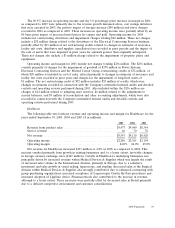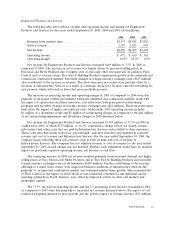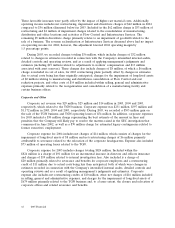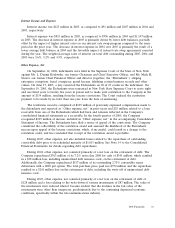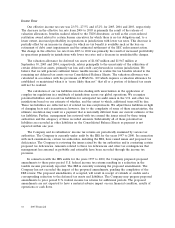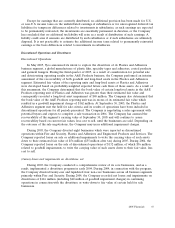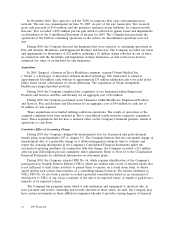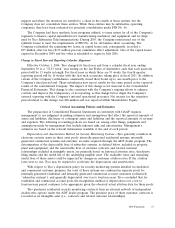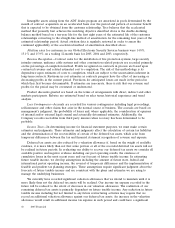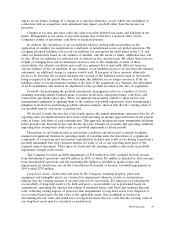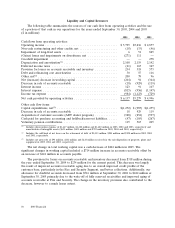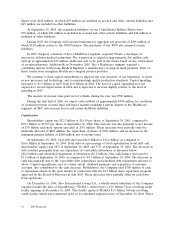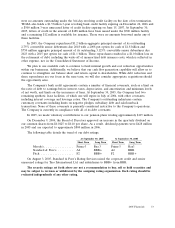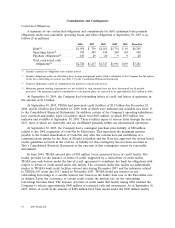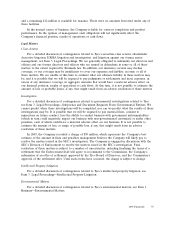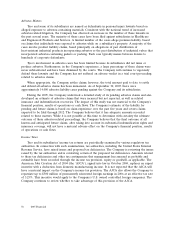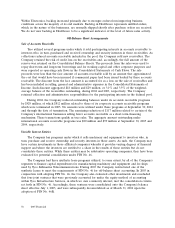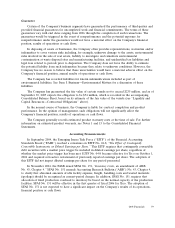ADT 2005 Annual Report Download - page 125
Download and view the complete annual report
Please find page 125 of the 2005 ADT annual report below. You can navigate through the pages in the report by either clicking on the pages listed below, or by using the keyword search tool below to find specific information within the annual report.impact on our future earnings. If a change in a valuation allowance occurs, which was established in
connection with an acquisition, such adjustment may impact goodwill rather than the income tax
provision.
Changes in tax laws and rates could also affect recorded deferred tax assets and liabilities in the
future. Management is not aware of any such charges that would have a material effect on the
Company’s results of operations, cash flows or financial position.
In addition, the calculation of our tax liabilities involves dealing with uncertainties in the
application of complex tax regulations in a multitude of jurisdictions across our global operations. We
recognize potential liabilities and record tax liabilities for anticipated tax audit issues in the U.S. and
other tax jurisdictions based on our estimate of whether, and the extent to which, additional taxes will
be due. These tax liabilities are reflected net of related tax loss carryforwards. We adjust these reserves
in light of changing facts and circumstances; however, due to the complexity of some of these
uncertainties, the ultimate resolution may result in a payment that is materially different from our
current estimate of the tax liabilities. If our estimate of tax liabilities proves to be less than the ultimate
assessment, an additional charge to expense would result. If payment of these amounts ultimately
proves to be less than the recorded amounts, the reversal of the liabilities would result in tax benefits
being recognized in the period when we determine the liabilities are no longer necessary. If the tax
liabilities relate to tax uncertainties existing at the date of the acquisition of a business, the adjustment
of such tax liabilities will result in an adjustment to the goodwill recorded at the date of acquisition.
Goodwill—In performing the goodwill assessments, management relies on a number of factors
including operating results, business plans, economic projections, anticipated future cash flows, and
transactions and market place data. There are inherent uncertainties related to these factors and
management’s judgment in applying them to the analysis of goodwill impairment. Since management’s
judgment is involved in performing goodwill valuation analyses, there is risk that the carrying value of
our goodwill may be overstated or understated.
We elected to make the first day of the fourth quarter the annual impairment assessment date for all
reporting units. Goodwill valuations have been calculated using an income approach based on the present
value of future cash flows of each reporting unit. This approach incorporates many assumptions including
future growth rates, discount factors and income tax rates. Changes in economic and operating conditions
impacting these assumptions could result in a goodwill impairment in future periods.
Disruptions to our business such as end market conditions and protracted economic weakness,
unexpected significant declines in operating results of reporting units, the divestiture of a significant
component of a reporting unit and market capitalization declines may result in our having to perform a
goodwill impairment first step valuation analysis for some or all of our reporting units prior to the
required annual assessment. These types of events and the resulting analysis could result in goodwill
impairment charges in the future.
The Company recorded goodwill impairments of $162 million in 2005, included in (loss) income
from discontinued operations, and $96 million in 2004, of which $36 million is included in (loss) income
from discontinued operations and the remaining $60 million is included in (gains) losses and
impairments on divestitures, net on the Consolidated Statements of Income. Goodwill impairments in
2003 totaled $278 million.
Long-Lived Assets—Assets held and used by the Company, including property, plant and
equipment and intangible assets, are reviewed for impairment whenever events or circumstances
indicate that the carrying amount of an asset may not be recoverable. For purposes of evaluating the
recoverability of long-lived assets to be held and used, a recoverability test is performed based on
assumptions concerning the amount and timing of estimated future cash flows and assumed discount
rates, reflecting varying degrees of perceived risk. Impairments to long-lived assets to be disposed of
are recorded based upon the fair value of the applicable assets. Since judgment is involved in
determining the fair value and useful lives of long-lived assets, there is a risk that the carrying value of
our long-lived assets may be overstated or understated.
2005 Financials 49


